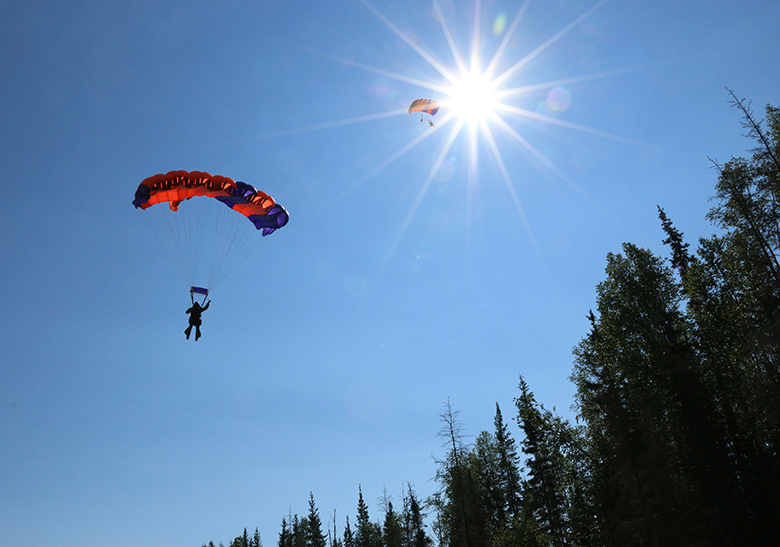
Alaska Smokejumper Recruitment
The Alaska Smokejumper Base is looking for hard working, physically fit, intelligent, and experienced wildland firefighters interested in becoming smokejumpers.
This page will cover the application process and requirements for the GS-5 Alaska Smokejumper positions. Rookies are hired into both Career Seasonal and Temporary Positions, dependent on openings and applicant qualifications. If selected, the candidate will begin one of the most physically and mentally demanding courses in wildland fire. Once the candidate completes the training, they will spend the remainder of their six-month season parachuting into remote and rugged terrain while suppressing wildland fires.
Requirements:
Smokejumper positions are not entry-level firefighting positions.
Rookie candidates are expected to have strong firefighting skills and working knowledge of fireline tactics before they are hired. Previous parachute training is neither required nor advantageous. The following qualifications are minimums. Successful candidates typically have 3-5 years wildland firefighting experience and can easily exceed the fitness standards.
Minimum Qualifications:
- Qualified Firefighter Type 1 (FFT1)
- 90 days on-the-line wildland firefighting experience
- One year of qualifying experience at the GS-04 level or equivalent*
*See Job Announcement for more details
Physical Training Requirements:
The physical training (PT) test is administered on the first day of rookie training.
Minimum Fitness Standards are as follows:
- Run 1.5 miles in 10:47 minutes or less
- Six pull-ups
- 30 push-ups
- Pack 110 pounds for 3 miles on level terrain in 65 minutes or less
*There is a maximum of five minutes rest between exercises.
- Arduous Work Capacity Test: 3 miles 45 pounds in 45 min or less.
Personal Attributes Required
- Service Oriented: The Alaska Smokejumpers is a service organization dedicated to performing with excellence every time we are called.
- Self-reliance, cooperation, teamwork: Smokejumping demands both self-reliance when the mission calls for largely independent action, and teamwork. Smokejumpers must be able to cooperate with firefighters and others from a multitude of agencies and backgrounds.
- Adaptability: Smokejumper candidates should realize that change, frequent travel, and uncertainty are part of the job. Smokejumpers must adapt well to rapidly changing environments and situations, prolonged periods of intense fire activity, and periods of no fire activity.
- Attitude: A positive, “can do” attitude is essential.
- Physical Fitness: Smokejumper specific duties demand exemplary physical conditioning. Smokejumpers are required to maintain peak fitness due to the extreme physical demands of the job; all jumpers must be in excellent condition. It is not uncommon to construct fireline for 14 to 16 hours per day on a regular basis. Both strength and endurance are of the utmost importance.
If you lack the above required experience, you may want to consider applying for a position on an Interagency Hotshot crew, fuels crew, district helicopter or engine crew. These crews receive valuable experience in fire suppression work. There are numerous crews located throughout the United States with the majority being in the western states. For more information on Alaska crews look online at North Star Fire Crew and Alaska Interagency Hotshot Crews. For more information on other crews, contact your local Job Service, BLM or Forest Service office, or browse for current openings online at www.usajobs.gov.
For more information, please contact Nick Biedscheid at 907-370-3744 or [email protected].
